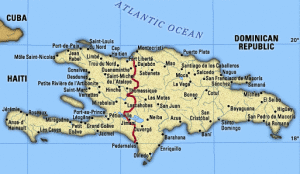Hervé Fanini-Lemoine
Hispaniola*
Hispaniola is the second largest island in the West Indies, containing Haiti and the Dominican Republic. Before Columbus, Hispaniola was known by the locals as Quisqueya – Mother of the Lands. It is sometimes spelt Kiskeya.
In 1794 a Guatemalan doctor and scholar, Paul Felix Cabrera, proposed that Hispaniola was Atlantis as well as a mysterious Atlantic island called Septimania. However, his theories, although revolutionary, were flawed by political bias against neighbouring Cuba. In the mid-19th century, Charles Etienne Brasseur de Bourbourg was another who proposed that Hispaniola was in fact a remnant of Plato’s Atlantis. In 1885 the American historian, Hyde Clarke, also suggested Hispaniola as a possible location.
The most recent advocate is Prof. Emilio Spedicato who proposes(a) the island as the home of Atlantis and contends that a consideration of the topography of Hispaniola suggests that the ruins of the capital city, if not completely destroyed by the catastrophic event (most probably a huge tsunami due to either an oceanic impact of a comet or an Apollo object or to the tidal effects of a planet passing close to the Earth) lie under thick sediments in the bottom of Lake Henriquillo, close to the southern coast of Santo Domingo, near the border with Haiti.
In January 2010 an archaeologist, Fianchy Torres, claimed(b) that a site in Manzanillo Bay in the northwest of the Dominican Republic, near the Haitian border, was the location of Plato’s Atlantis(c). He based his contention on anomalies he found on Google Earth images and sea level changes. Similar underwater anomalies have been identified in Peru, near Puerto Rico as well as the Canaries, which appear to be the result of data processing errors.
The idea of Atlantis in Hispaniola, inspired by the work of Spedicato, is now supported by the Kiskeya-Atl Research Center(d), which has announced that it will host a three-day conference in November 2018, with an invited panel of “renowned scholars and researchers on the topic.” Hervé Fanini-Lemoine, is one of the founders and current chairman of the Research Centre. Its purpose “is to research and find artefacts to sustain the hypothesis which says the lost land of Atlantis is, in fact, KU-ISH-KU-EYA, ‘Mother of Lands'”.
Andrew Collins who proposes Cuba as the location of Atlantis has offered a critical response to Spedicato’s Hispaniola theory in both Gateway to Atlantis and its revised version Atlantis in the Caribbean.
(a) https://www.academia.edu/10973532/ATLANTIS_IN_HISPANIOLA_
(d) Kiskeya Atl Research Center – Overview, News & Competitors | ZoomInfo.com (link broken) *

